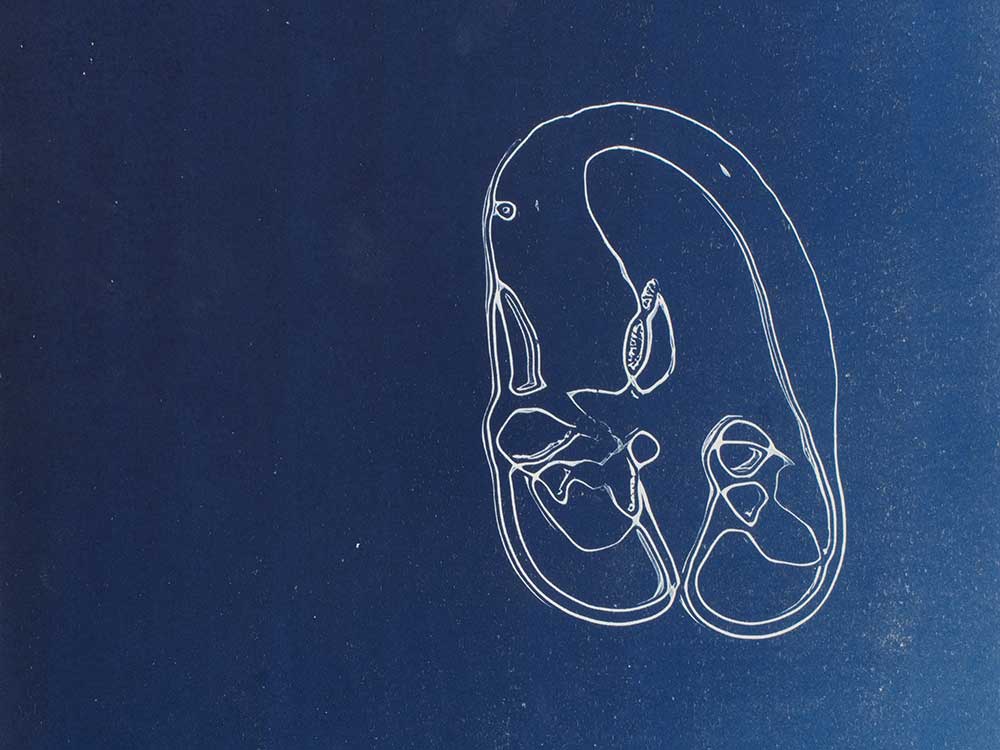
Khazar Archeological Confabulations
2023, AI algorithm, speculative archeology object database, cyanotype on paper
The Khazars were Judeo-Turkic tribes converted from Tengri Shamanism - a belief in the titular sky god and the eternal blue sky - into monotheistic religions. The story of their conversion to Judaism, “The Kuzari”, is a core text in Jewish Philosophy. However, all three Abrahamic religions were practiced freely and harmoniously within the Khazar kingdom. The story of the Khazars is a story of communal flourishing, peace, and coexistence among peoples with different religions and ideologies.
In Khazar Archeological Confabulations, Astarhan re-figures Khazar pasts through digital technology. In 2019, an archeologist from the University of Astarkhan, a city on the Russian steppe with a name identical to the artist’s last name, unearthed the lost Khazar capital Atil - a modern Atlantis. Using a database of artifacts from the excavation, a home-brewed AI system generates a vocabulary of object drawings. The result are abstract, cell-like drawings, calling for a projection of what Khazar futures might entail. The images are then turned into Cyanotypes exposed to natural light, reestablishing lost anscestral connections through the sky dome. The cyanotypes conjure Khazar Tengrist mythology with toxic-free, sustainable imagemaking, and examine relationships between the societal roles of ancient belief systems and ominous technologies.
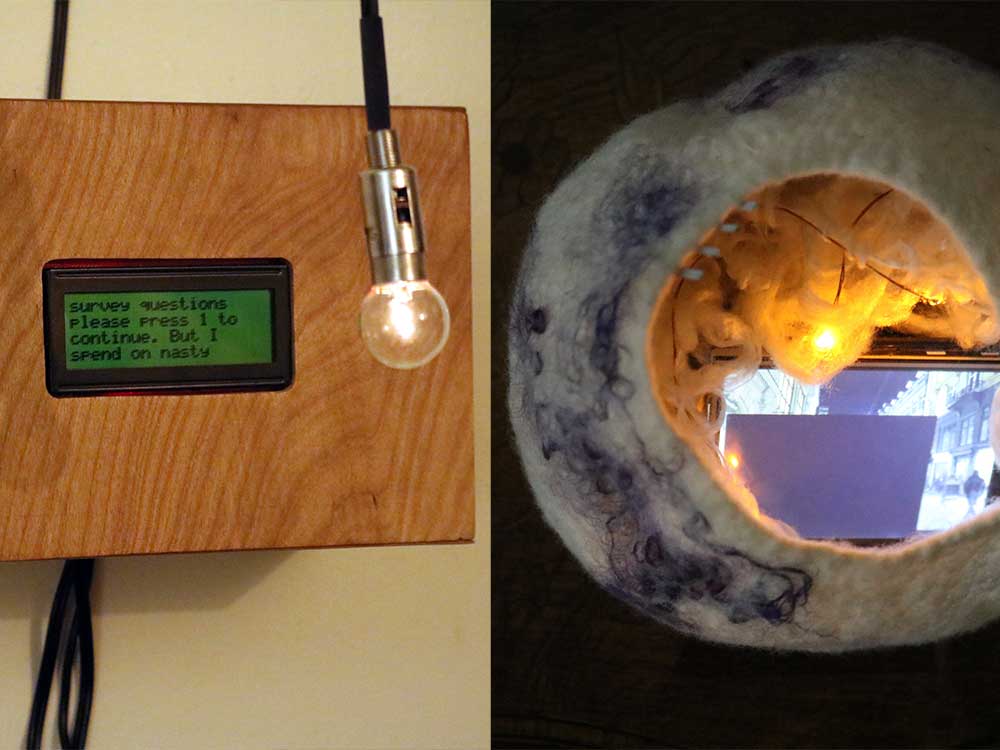
Transmissions From The System
2016, Light, LCD, Micro-controllers, MP3 player, Electronics, Custom Programming
The screen shows algorithmically transcribed voicemail messages while the voice volume is mapped to light bulb. No audio is present. Light and text are communication remnants, while technology obscures the content and the human connection.
Memory Capsules
2019, Wool, silk, breath sensor, LED’s, micro-controller, WiFi, LCD, custom software
A breath awakens a memory to the screen. As our own breath sustains us, our memories sustain us. Memory Capsules seeks to nurture memories through preservation. Technology’s role is called into question, as algorithms curate different narratives, while erasing others.
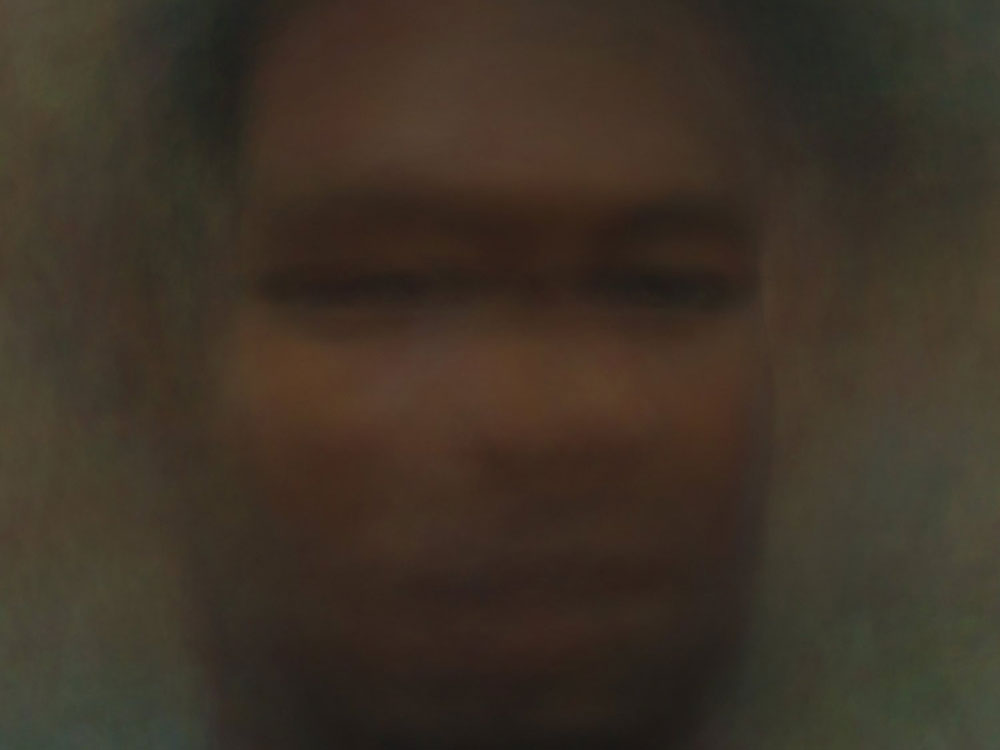
the Dark Database
2020-Present, Archival Inkjet Print, 20" x 20".
The Dark Database series looks at the bias inherent in facial recognition systems. Using Open Computer Vision and the programming language Python, a facial detection algorithm was run on a series of films by directors of color. Each of the faces detected was stacked and centered according to a portrait template. The median pixel value for each detected face is calculated to create one single portrait of the film that serves as a kind of record of all the faces the facial detection algorithm was able to detect. Current studies show that facial recognition systems are less able to detect a face in an image when the skin tone of that face is not Caucasian. The undetected faces are then not enrolled in the systems’ database. As a result many of the systems are trained using datasets which contain fewer people of color, making those same systems inaccurate when recognizing or identifying individuals of color. The Dark Database is a kind of record of visibility and representation as seen through the eyes of artificial intelligence.
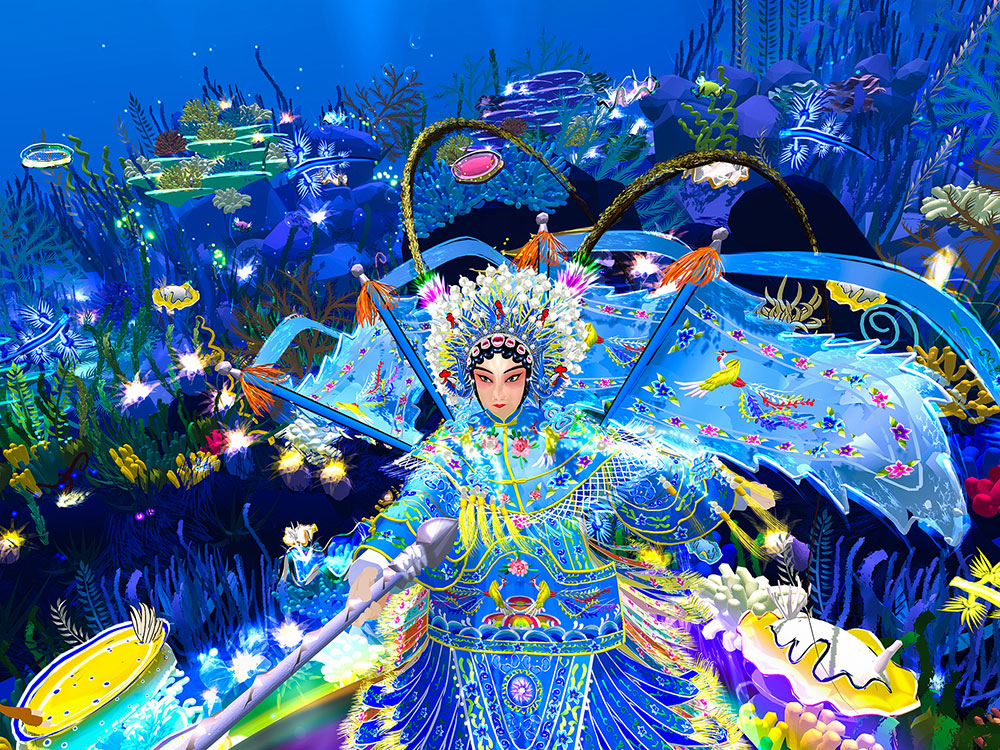
Mulan
2022, Virtual Reality. Duration: 3:00
A video-based work created through virtual reality, Chun Hua Catherine Dong’s Mulan reimagines the legendary Chinese folk heroine to explore gender and the body's plasticity. Inspired by ancient Chinese storytelling, performance traditions, and marine biology, Dong used 3D VR tools to create an imaginary aquatic fantasy world where Mulan merges with the nudibranch—a colorful deep-sea organism known for its unique forms and ambiguous gender identities. Adorned in a vibrant Beijing Opera costume, Mulan becomes a hybrid being, part of the marine ecosystem. This work challenges historically male-dominated theater traditions and proposes new pluralities within this iconic folk character.
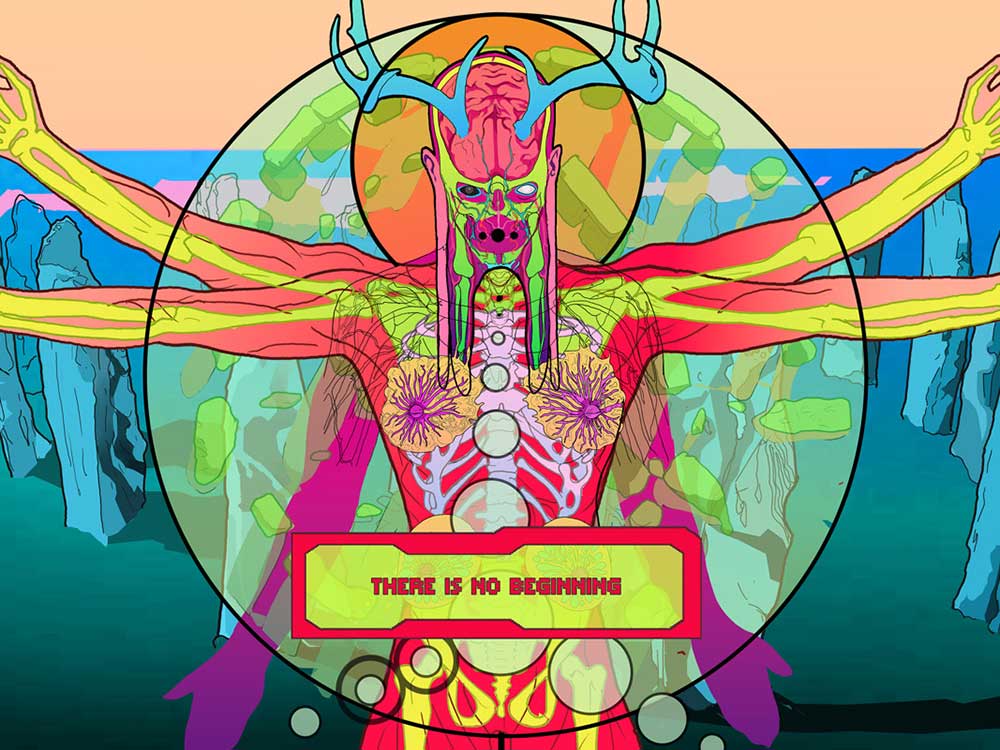
Liturgy 1.11 (The Growing of a God)
2024, Single-channel video, duration: 5:40, featuring [M] Dudeck, Annette Elster, Stefania Peterlini (vocals), original composition by Brandon Michael, 2024.
Liturgy 1.11 The Growing of a God is an animated single channel video installation, chronicling the genesis of the RELIGIONVIR.US COSMOVERSE, a queer sci-fi mythology and religion I’ve been inventing and disseminating for the past fifteen years. I seek to radically expand the category of the sacred by producing temples for outcasts, mutants, heretics and aliens to heal from the trauma of religion. Featuring an original soundscore produced in collaboration with electronic composer Brandon Michael, and an invocation performed in English and my invented queer alien language, Liturgy 1.11 is a "rebuild" that re-mixes and re-animates artifacts from my transmedial scriptures, and repackages them into a psychedelic invocation.
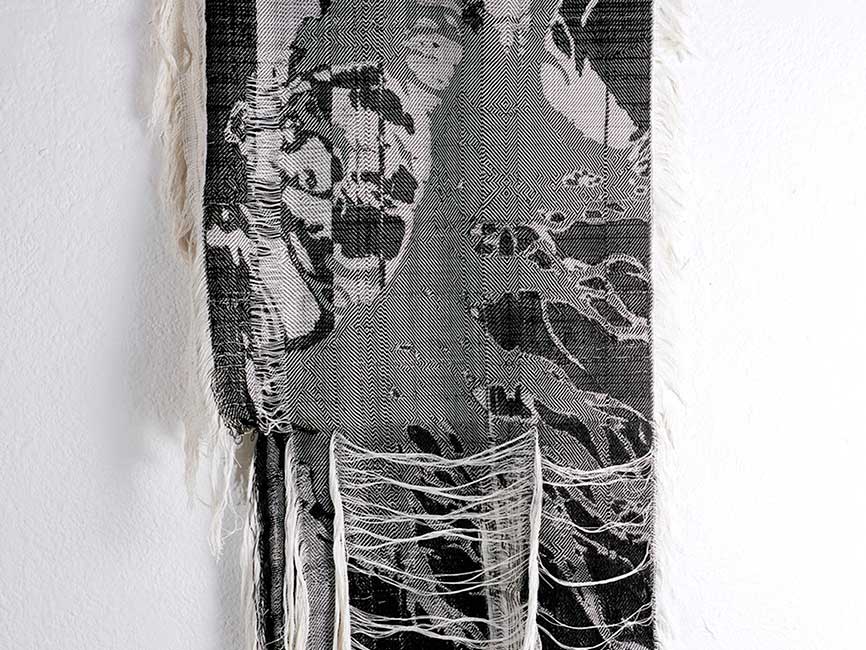
beach hairs Peter
2022 ~24 X ~46 in. cotton, synthetic polymers
A selfie is refracted through processes of depiction/materialization; digital imaging and translation to weaving draft and then handweaving by digital jacquard. The image is a still of the subject moving through space, long hair floating to the side. Disconnection between the subject and viewer is continued through an upside-down orientation, reflecting Peter's desire for an inverted crucifixion, feeling unworthy of a format similar to Christ's.
honeystillfloats
2019, diptych: 38 X 24 inches each; cotton, synthetic polymers
Handwoven digital jacquard; a screenshot still of a video performed outside Big Bend/Marfa, TX. Inverted with intentional and unpredicted glitches expressing a negotiation with a machine breaking down as it facilitates weaving the piece. Ghost images of a figure suspended in space and time with ambiguous hands result.
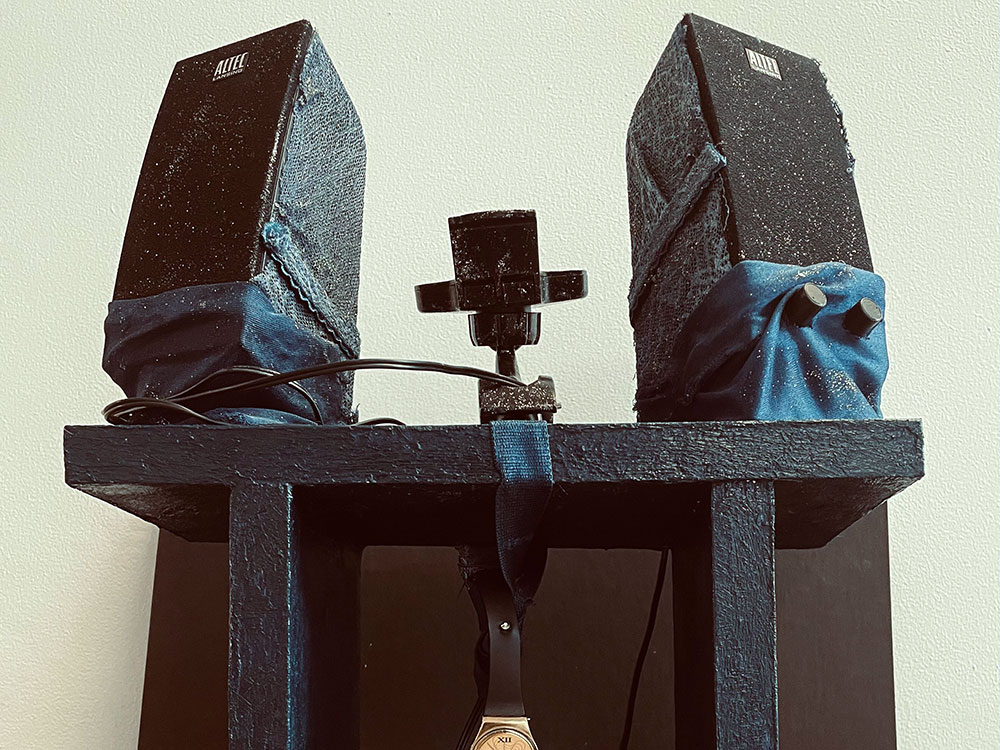
ALTeks
2023, ALTeks: Anansi's Digitation Time Device: Dimensions: H: 16.5in by W: 11in by L: 5.5in Medium: Assemblage- wood, jeans, wristwatch, speakers, charging port, blue acrylic paint, blue cloth, black thread. ALTeks: NGLitcholalia: Digital/Sound recordings on website.
ALTeks is a project series centered on the creation of sacred technologies, sacred archival and repository pieces and spaces and alternative storytelling/counter-sciences inspired by Black Afro-diasporic histories and possible futures. ALTeks, which is a fusion of altar, alter and tek (the root of words like text, technology and texture), looks at how to reimagine and re-story various aspects relating to Black Afro-diasporic culture and histories, and how Blackness is conceptualized in the world. These complementary pieces, ALTeks: Anansi's Digitation Time Device and ALTeks: NGLitcholalia explore sound, music and language as acts of horology, the fabrication, of time devices incorporating aspects of Afro-diasporic, Afro-Caribbean cultures. ALTeks: Anansi's Digitation Time Device is influenced by West African spider trickster Anansi, my Caribbean heritage and sound system culture, the relationship between time and language, and the history of indigo and textiles. ALTeks: NGLitcholalia, inspired by Caribbean creole languages, crafts possible poetic meanings of words I created, collecting roots of each part of a word across time and space.
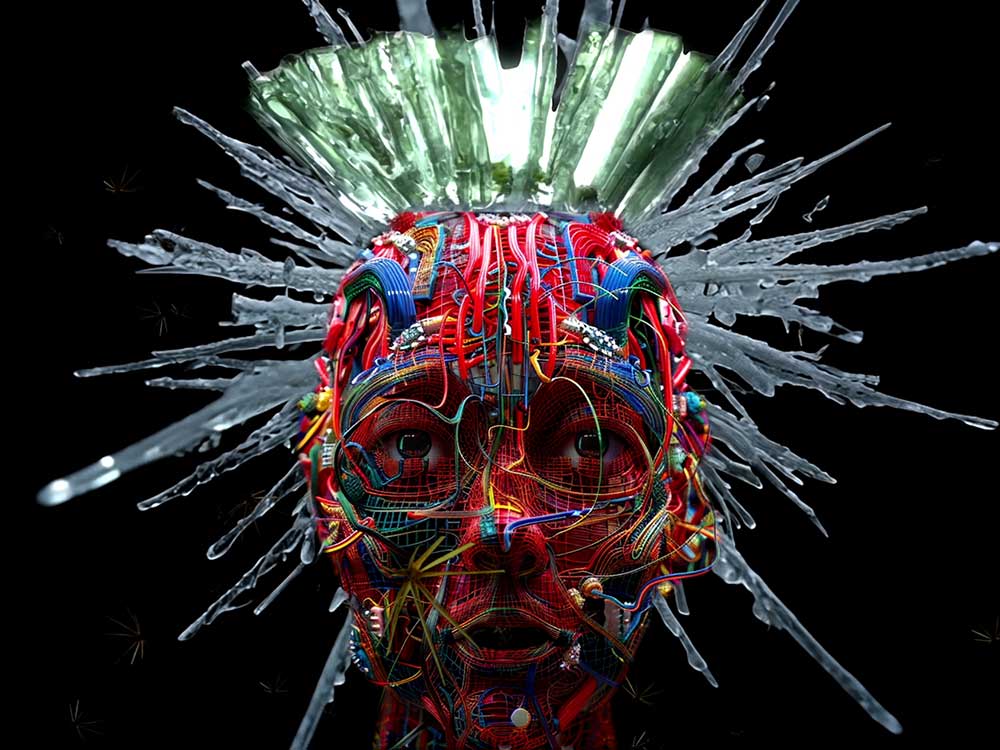
Tell me what you see outside (stalactite crown mix)
2024, video, digital animation. Duration: 8:00
When we became awake, we saw that we had been asleep. From a distance we call to each other, communicating with loud, drawn-out cries. Blue and yellow racing diagonally through the sky. One hand stretched out, while the other forms a magical sign. We are travelling with the strange language. We are travelling with sweet laughter. We have to stay brave, energetic, and stubborn. Grow dank warm skins of green velvet. Bare dirty infectious teeth to pierce the skin-border between labour and Capital, chained to our incendiary dragons and prepared for death. Howling discordant odes to the Anthropocene, our story will never really exist, never be completely written. The fire is tired of waiting.
Our work unsettles boundaries and binaries: real/virtual, human/more-than-human, ecological/technological, nature/society. We code/switch, iterate rules, glean, reassemble fragments, build black skies, craft twig babies, summon avatars who hexecute spells. We dream in a state of dissonance, collectivity grappling with collapse, sleep-breathing the cinders of a burning system that ignores those condemned to breathe ash under red skies. Our accomplices in reverie are here, speaking and unspeaking in Tell me what you see outside. Gleanings: Mammad Aidani, Maria Alyokhina, Eileen Myles, Lady Sarashina.
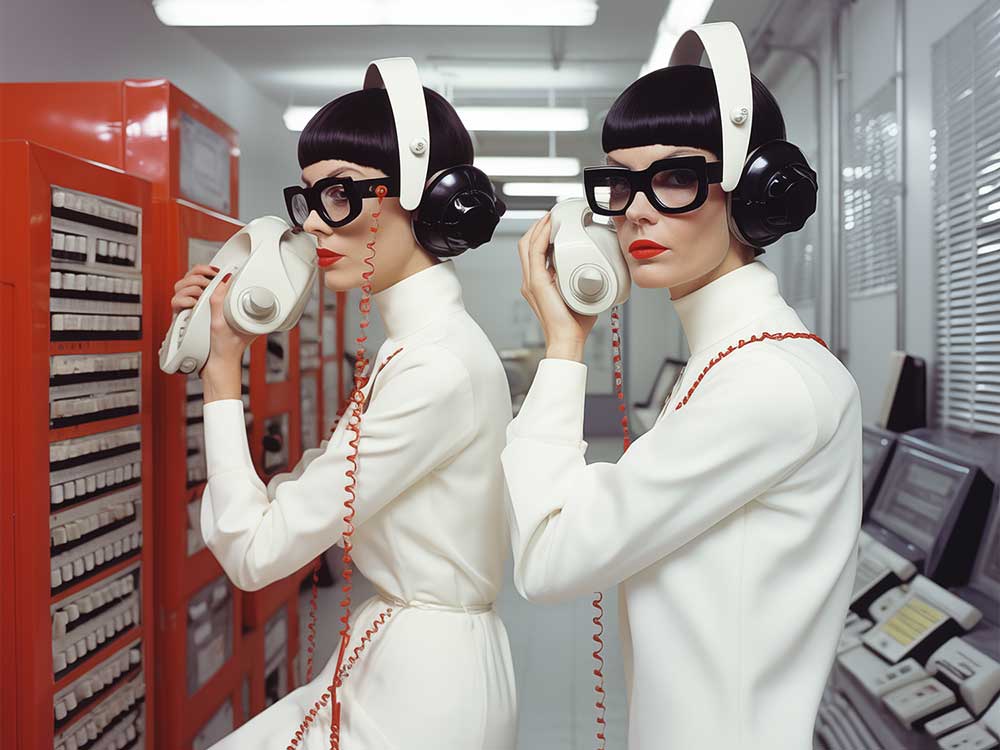
TwinArt in the Museum
2024, digital printed fabric and digital slideshow/video
As TwinArt, we collaborate to expand our ongoing twin lexicon through art and technology. Our work centers on everyday life while reflecting the interconnected nuances of the twin experience. We layer design elements with personal imagery embracing the fluidity and multiplicity of the twin bond as a catalyst for creative endeavors.
Introducing futurists Elka + Lyka fem-bots replicas who expand our imagination through the wonders and collaboration of artificial intelligence in the TwinArt in the Museum series. We use AI and computer software to create our twin-muse characters in stylized scenarios. TwinArt invites viewers a glimpse into their idealized narratives while pointing to the imperfections in the virtual twin world.
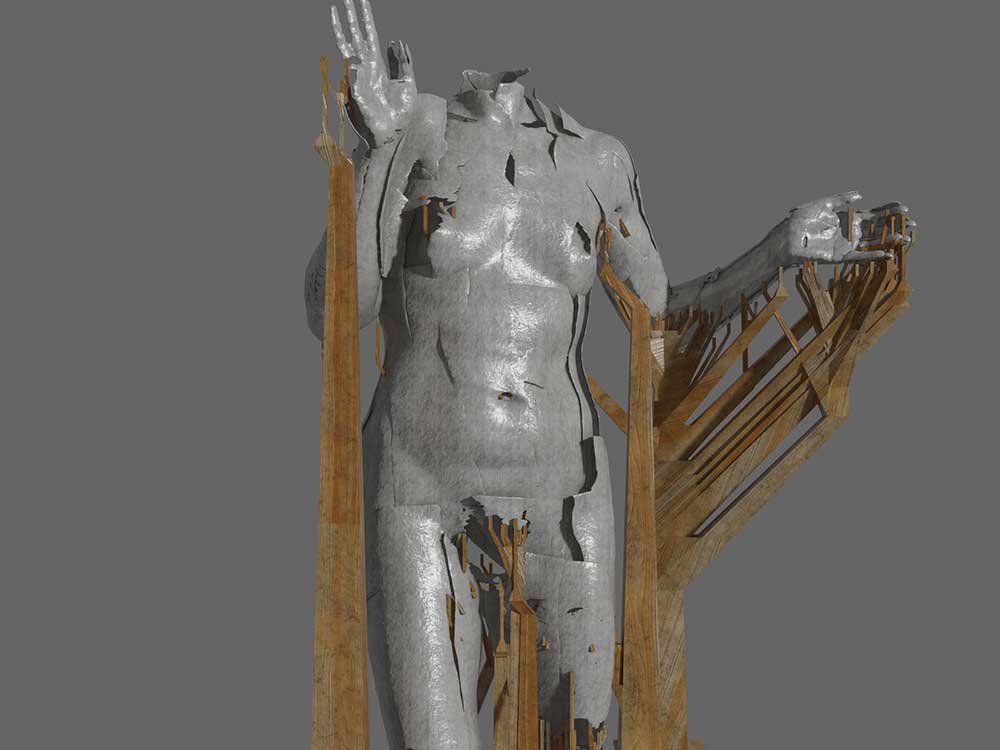
Periode des Attitudes Passionelles: I ii, v1
2021, Glb file
Machines for Suffering is the result of my ongoing investigation into female hysteria, a once-prevalent but now-discredited medical diagnosis that was applied largely to women. At the Salpêtrière hospital in nineteenth-century Paris, which housed thousands of supposed hysterics, patients were hypnotized, subjected to electrical stimulation and 'ovarian compression' among other treatments. They were then led to perform attacks on stage at weekly teaching lectures, and were extensively photographed.
I was fascinated by the folly of using the technology of photography to attempt to capture and codify madness. I used documents from the Salpêtrière to choreograph a group of dancers, who reenacted the poses for the 3D scanner. I then edited and 3D printed the fragmented scans that resulted. The final sculptures and renderings incorporate intricate scaffolds which serve to support the fractured bodies, suggesting a woman whose body, or psyche, is subject to a process of construction or demolition.
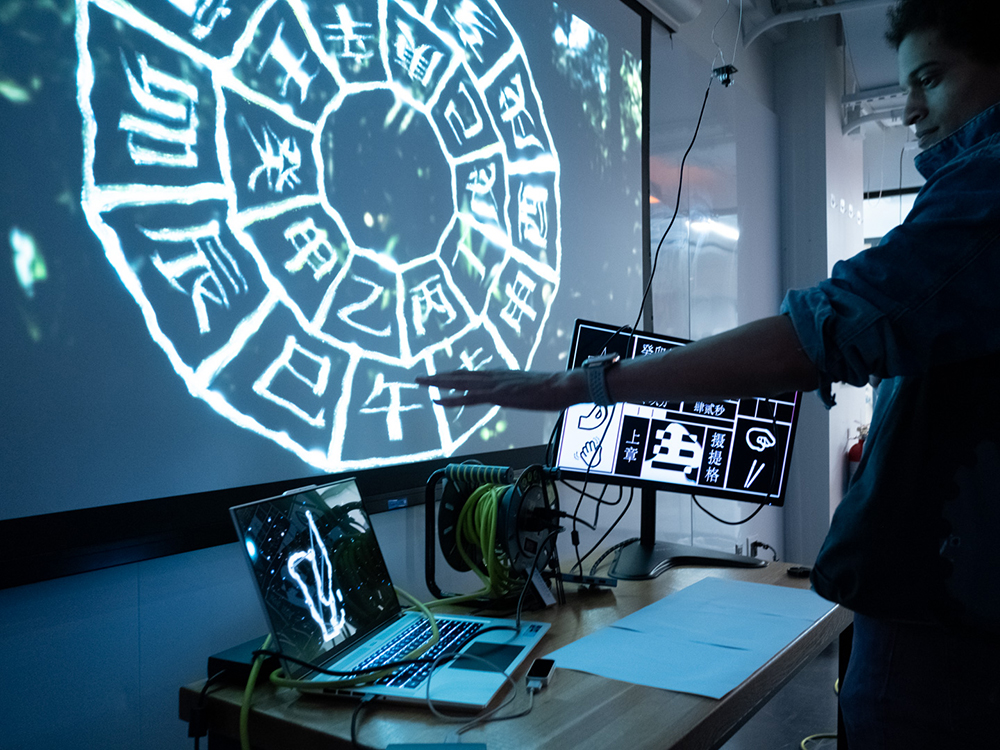
天机: Cosmic Computing Unit
2023, Custom software, custom hardware
天机: Cosmic Computing Unit is an interactive installation inspired by the divination process described by Yi-Ching. Fortune telling in Mandarin, 算命, can also be translated as 'computing fate'. This coincides with the divination process documented in Yi-Ching which is entirely based on binary arithmetics, and coincides with the foundation of all modern digital computers. The installation essentially automates the Taosist divination by transcoding location (longitude and latitude, time (season, year, month, date, and time of day), a sigil that the viewer drew in the air and captured by a hand tracker, and a random input (cardinal directions of fallen stickers) into binary numbers and computes through digital clock and computer vision, and computes the divination output for the viewer. The computation process will be visualized as generative graphics and music compositions.
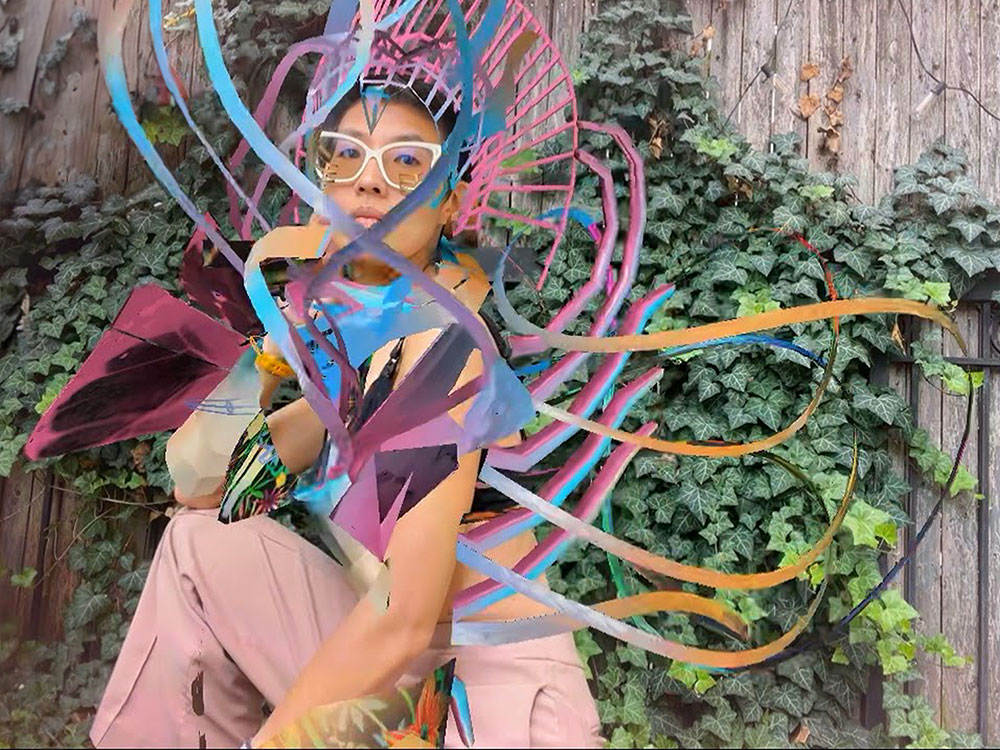
Powered by the Glitch
2024, screen, computer, webcam, custom 3D models, AR software
Powered by the Glitch explores the intersection of art, technology, and social activism through feminist cyborg theory and an interactive augmented reality (AR) installation. Audiences engage with their inner glitch, becoming feminist cyborgs through AR, challenging norms, and embracing identity fluidity.
The project interrogates how virtual personas influence real-life identities, proposing a synthesized identity merging both realms. Embracing the glitch as resistance and transformation, it disrupts binary logic, celebrating hybridity and the in-between, aiming to dismantle societal expectations of women's perfection and constant performance for the world’s gaze.
Rooted in Legacy Russell's concept of the glitch as "a form of refusal, a strategy of non-performance," the project interrogates the possibilities within conformist systems. Participants will explore new forms of identity that emerge from the disruptions and imperfections inherent in both technology and nature. Additionally, the project will feature a cyborg feminist AR performance, offering a dynamic exploration of these themes.

Olympic Doula Nicky Dawkins (Double Consciousness Infinity Mirror)
2020-21, 36"x48"x4" 2 way surveillance security mirror, solar car tint, photo print on acrylic, neon LED, PVC mirror
Griot Doula Nicky Dawkins (Coralina's Mama Spa Botanica collaborator) was documented 9 months pregnant as she prepares for labor on the front lines of the birthing justice crisis crowning in Miami during the 2021 corona virus pandemic, where violent legislation forbids lifesaving doulas from delivery rooms. During her Mama Spa Botanica workshop photo shoot, Nicky describes the technological vulnerability of our humanity: "Sonograms can depict the eyelashes of a fetus in utero, but we still can't 'see' black or brown women in America. How long will our labor be invisible."
The work illuminates the intersection of medical violence and surveillance technology with reproductive health policy. Offering the Griot as fertility effigy, the infinity mirror harnesses the 2 way security mirror in police line ups as a site for matriarchal endurance, ancestral divinity and reflective resistance. Nicky's double burdened photograph and the viewer's reflection disappears infinitely into a neon greenscreen mirror as a call and response through biological bonds and biographical bondage. An optical illusion implicates the viewer as a witness to technology and AI Ancestral Intelligence passed on through the Linea Negra.
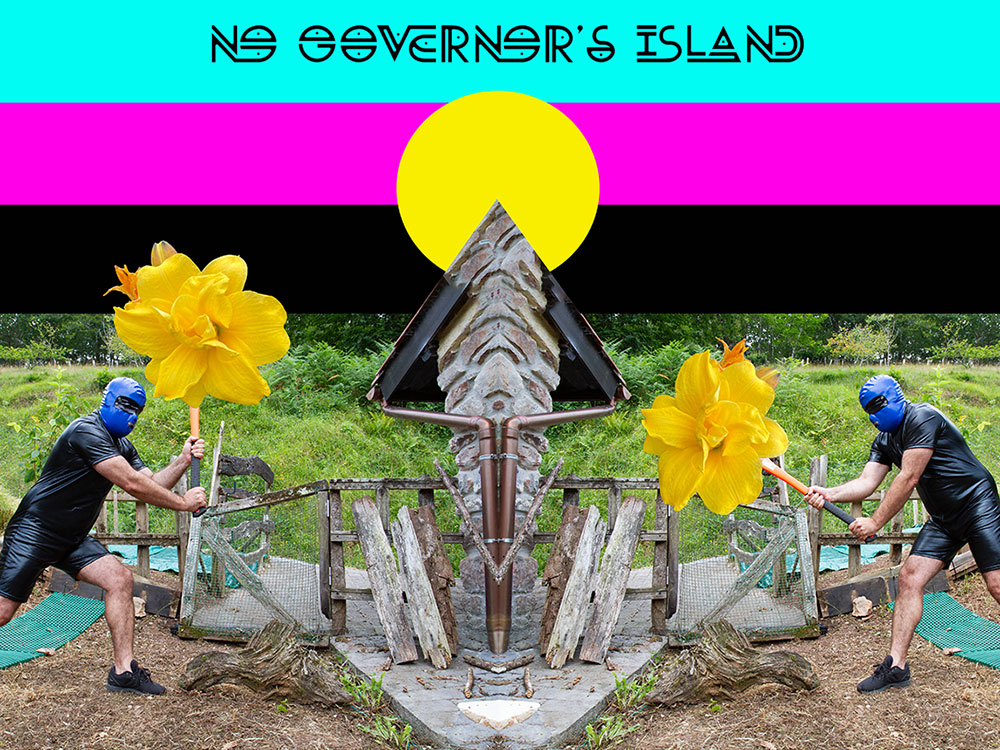
Queering Utopia- No Governor's Island
2023, Video- photography- watercolor- ink. Duration: 40:13
Queering Utopia - No Governor's Island is part of a series of Andrés Senra's latest works on queer futurism, featuring concepts of hybridization, cyborg theory, inter-species relationships, and gender-fluid beings. The storytelling in the video art results from a conversation between Andrés Senra and an AI. This work narrates the creation of a queer human-nonhuman and AI utopia in a post-apocalyptic world following a global environmental crisis. Governors Island is chosen as the location to create this new queer future. Through speculative fiction, it highlights how cishetero patriarchy and colonialism have led to the domination and exploitation of the planet by humans. In its next steps, the project will be open to contributions through group discussions with queer communities to imagine futures with new intertwined relationships among humans, nonhumans, technology, and nature from an eco-queer perspective.
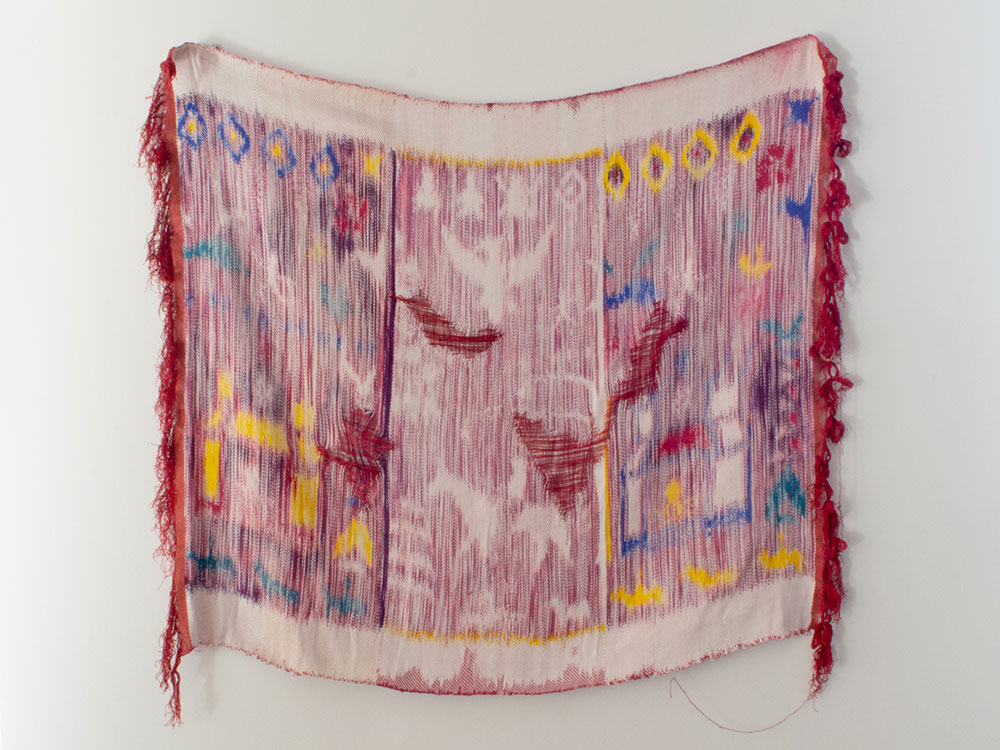
Deities in Temples III, Deities in Temples VII
2023, 2024, Visuals drawn by family members, silk threads (printed then woven with), dye
Deities in Temples examines recently recovered and translated (from French to English) museum registration cards that verify the existence of lost Pidan weavings. Pidan weaving, a traditional Cambodian silk weaving technique passed down matrilineally, was nearly eradicated during the Khmer Rouge Regime. The work aims to decolonize their legacy through the interpretations provided by Sok’s family members. Through various digital exchanges—including drawing, painting, writing, and video calls—Sok’s family members guided the creation of new Pidan weavings to replace the missing textiles. Contrasting her family’s forced migration from Cambodia to Australia with her own migration to the US, the virtual space bridges physical separations and allows for the continuation of familial and cultural connections that were previously inaccessible to past generations.
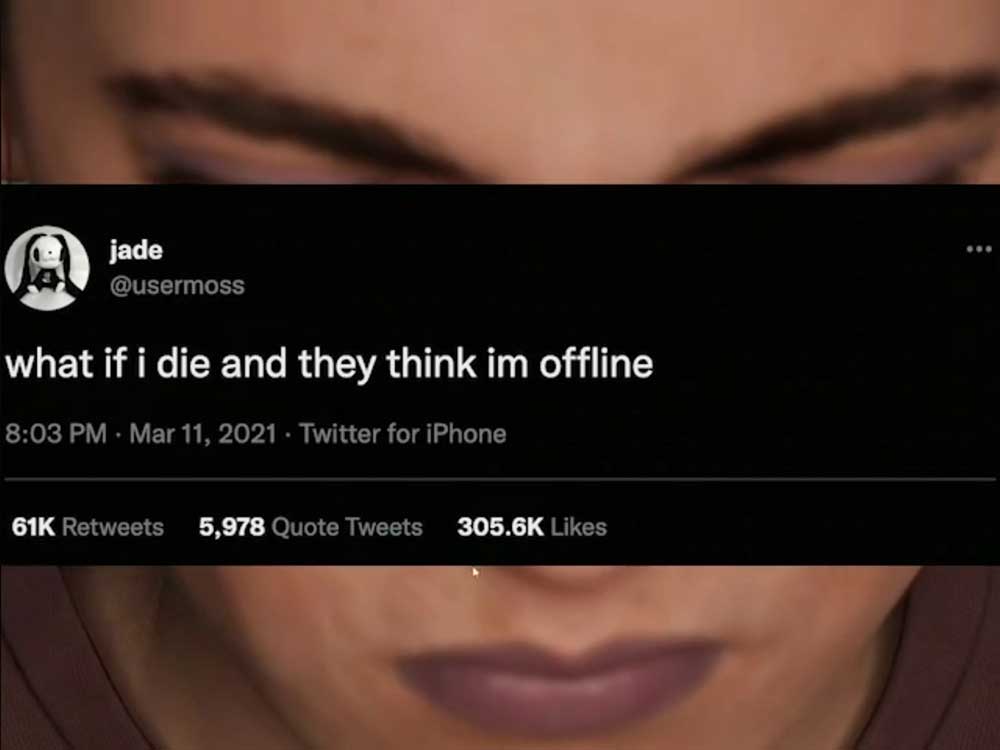
Social Mediums
2022, Archive footage, AI produced voiceovers, screenrecordings. Duration: 3:21
In Social Mediums, a fictional company named: FOREVERPOST ® hires salesmen to sell "afterdeath" social media packages, "to keep the memories of those we’ve lost, alive."
Comprised of archival footage from corporate sales training videos used by the Ford company in the 80's, as well as AI produced voiceovers and screen recordings, the video serves a teaser for a script currently in development.
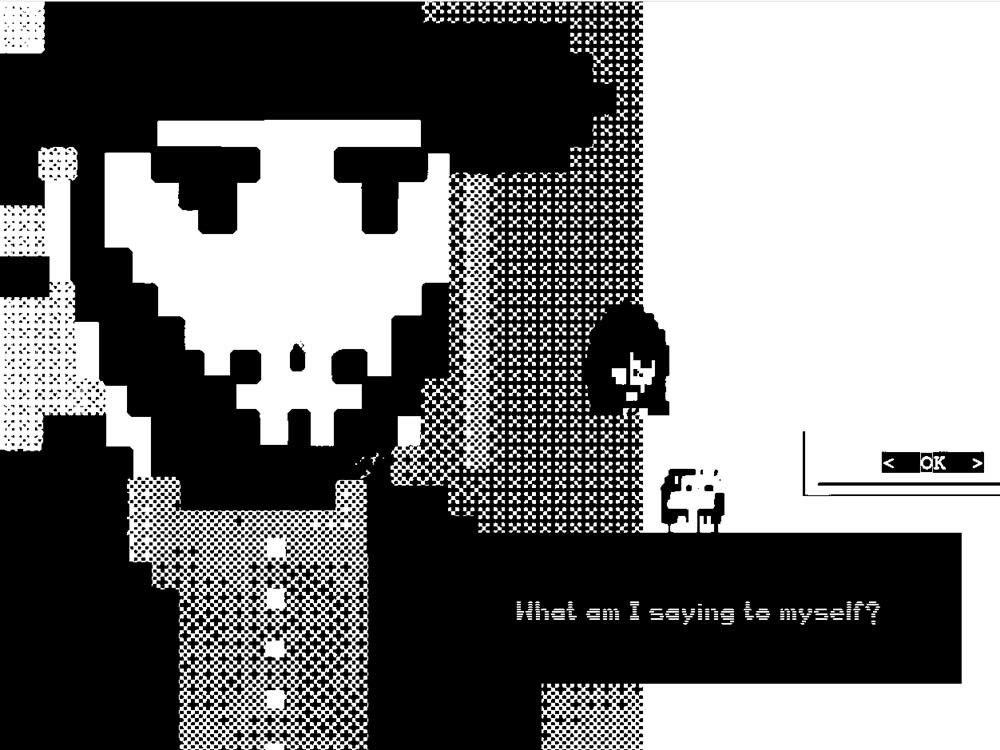
Borscht Belt System
2024, Custom Software (p5.js), Digital Drawings, ML-assisted drawing
Borscht Belt System is an infinite-running software system. The term Borscht Belt references the informal and now defunct community in upstate New York that was home to Jewish immigrant families on vacation in resorts catering to the community. This Borscht Belt System is a simulation, a self-playing AI repeatedly prompting itself with psychological questions, never answered, inside a digital ecosystem. The characters in the system include traditional Orthodox shtetl inhabitants from the pale of settlement from previous centuries, wandering among modern assimilated characters, turned loose inside the bowels of a computer. Over time, characters degrade or are hollowed out. Their form becomes harder to identify, or they become more distinctive. The soundtrack is a 1919 recording by Joseph Frankel's Orchestra playing an improvised Jewish nigun, an ancient wordless melody traditionally sung by a synagogue, here performed as if in joyous celebration.
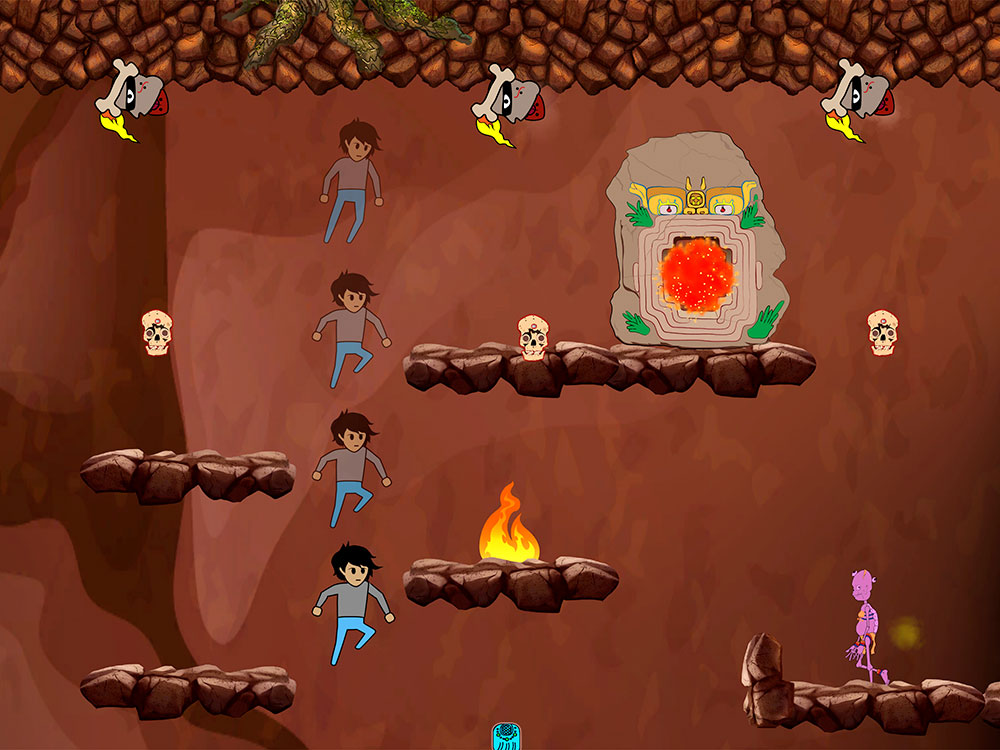
esfuerzo
2024, 2D video game, newsprint poster. Music by: Huang Luming
esfuerzo (effort) is a multimedia project consisting of public workshops, a print publication, an informational website, and a narrative-based video game informed by the history of U.S. immigration policy to solicit ideas for new immigration policies and visas that reflect today's reality. Conceived during the summer of 2022 when more than 152,000 unaccompanied migrant minors reached the Mexico/U.S. border seeking asylum, the project is two-fold: to present an accessible dual-language index of U.S. immigration history and to workshop ideas for a lasting, functional immigration policy. The 2022 wave of unaccompanied migrant minors to the United States were primarily from El Salvador, Guatemala and Honduras- lands that were largely Mayan. esfuerzo’s visual language is informed by Mayan art and culture. The platformer-style video game draws from Mayan religious traditions as a framework to present a hero’s journey. Elements of Mayan mythology are dovetailed with a history of U.S. immigration to reflect a continuum of the human experience and a fluidity of culture.

















